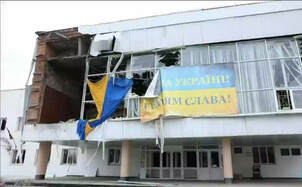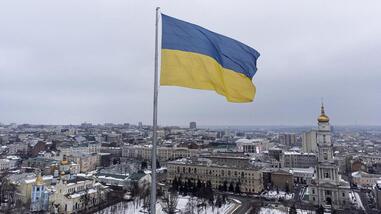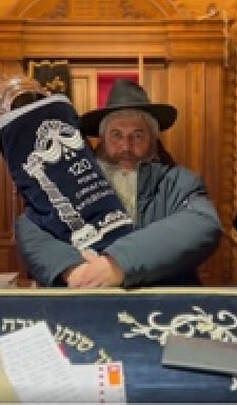 The Ukrainian town of Makariv, 30 miles west of Kyiv, hit the headlines last week as the first settlement retaken from the Russian army by Ukrainian fighters. The blue and yellow flag flies once again in my great-grandfather’s home town, giving this unremarkable Soviet-style city a symbolic importance that it hasn’t had for many decades. Makariv, like so many places in Ukraine, has suffered dreadful horrors in the last month. Photos show buildings turned to rubble, burnt-out cars, shops on fire. “Welcome to hell,” the Independent quotes a soldier at the checkpoint saying. Most of the population has fled. Electricity and water supplies have been cut off and little food is available. Municipal offices, a market, school, church and internet tower have all been bombed. The few, mostly elderly, people who remain are scared to leave their homes. A video shows a Russian armoured carrier blowing up a car with an elderly couple inside. Makariv is known for its bread – a soft, white loaf made from the local wheat. At least 13 workers died when the bakery was shelled earlier this month, around ten more were freed from the rubble. My great-grandfather, whose name was Meyer Unikow, died just over a century ago, one of three brothers from Makariv who perished within a fortnight of each other during the typhus epidemic of 1919. He is sitting second from the right in the banner photo – taken in Makariv – on the blog page of my website. On the far left is his brother Berl, another of the three who died of typhus. When Meyer lived there, Makariv was symbolically important for a very different reason. It was the home of an important branch of the Hasidic Twersky rabbinical dynasty. The Makarov (to use the Russian spelling) dynasty was founded by Rebbe Menachem Nachum Twersky in 1837. Meyer was brought up at the Twersky court, where his father and uncle worked, and was educated with the rabbi’s sons. When Meyer was born in 1873, there was just one synagogue in Makariv. By the end of the century there were six. By this time, almost three-quarters of the town’s population were Jewish. A Jewish savings co-operative was founded in 1912 and in 1913 a Jewish hospital. In 1914, all three of the town’s drugstores, 85 shops, a tavern, two honey factories and two timber yards were owned by Jews. Five years later, the Jewish population was decimated. In 1919, during the Russian civil war, Makariv witnessed some of the most brutal antisemitic pogroms. Gangs – or banda as my grandmother called them – murdered 20 Jews on 6 July and 15 August that year, prompting most of the Jewish population to flee. The Volunteer Army of General Anton Denikin arrived on 18 August and killed half of those who remained, including 17 members of a Jewish delegation sent to greet them. A further pogrom took place on 6 September. The website jewua.org quotes Chaim Frimgod, who witnessed Denikin’s pogrom: “On Monday August 18, the Volunteer Army entered Makarov. Jews with bread and salt went to meet them, but this present was rejected. Immediately they began to beat the Jews, they took their boots and dresses off and gave them to local peasants. Jews were caught in the streets and shot. About 50 elderly men were shot during the pogrom. They killed five to six Jews a day. It was impossible to escape from the shtetl. It was impossible to escape from the shtetl as there was risk of being killed on the road out. Bodies of dead Jews lay in the streets, dogs and pigs were nibbling their heads. Afterwards peasants threw the bodies into mass graves in groups of 20-25. About 80 Torah scrolls were destroyed.” Very few members of the Jewish community ever returned to Makariv. By 1926 the Jewish population had dropped to below 600, from around 4,000 at the turn of the century. Many of them worked on a collective farm that was established in Makariv in the 1920s. During the Holodomor – the great famine that killed millions in Ukraine in 1932-1933 – the collective farm provided food for local children, helping to save their lives. The farm became the scene of mass shootings in September 1941, when Nazi forces occupied the town. More than 100 Jews were murdered in Makariv in July-November of that year. Just a handful of Jews lived in Makariv when I visited the town in 2005, all of them incomers. No descendants of the families who had been there before the war still lived in the area.
0 Comments
 This evening I was supposed to be attending a candlelit vigil for the people of Ukraine and giving a brief personal testimony. Unfortunately Covid had other ideas, so my words will now be spoken by someone else. It won’t be so personal, but the sentiment is the same. Here is what I planned to say: My grandmother came from the village of Pavoloch, about 60 miles southwest of Kyiv. The area has witnessed untold suffering over the last century, and is suffering once again today. The nearest town to Pavoloch is Bila Tserkva, which has been hit repeatedly by Russian missiles fired towards Kyiv from the Black Sea. Photographs show buildings flattened, the ground strewn with burning rubble. You may have watched the video of a Ukrainian musician playing her piano one last time in a bombed-out apartment before fleeing. That was in Bila Tserkva. A hundred years ago, this area was a battleground of a different kind, as the Russian Civil War raged across Ukraine. Numerous armies – ‘banda’ as Grandma called them – criss-crossed the land – Communists, Nationalists, Anarchists, anti-Bolsheviks, peasant militias. My family was Jewish and all of these banda were anti-Semitic to a greater or lesser degree. Around 100,000 Jews are estimated to have been murdered during the pogroms that accompanied the civil war, on top of the thousands killed or injured during previous waves of pogroms in the same part of the world. As well as violence during the civil war, there was hunger. Food had become scarce during the long years of World War l, and inflation soared, making what little there was unaffordable. On top of this, the Bolsheviks requisitioned grain – including from my great-great grandfather, a grain trader – to feed the workers in the towns. Not only did they requisition grain, but also seed, leaving the peasants with nothing to sow crops for the following year. The countryside was left to starve. Grandma was about 17 years old at the start of the civil war, and an orphan. But she was part of a large household, living with her grandparents, siblings and cousins. Grandma took it upon herself to become the family breadwinner, undertaking terrifying, illegal journeys by train to markets across the region to buy, sell and barter what she could to keep her family alive. Eventually she became a black-market gold dealer, taking gold hundreds of miles across the country to Kharkiv and bringing back hard currency in return. If caught, she would have been shot. Grandma was a tiny, delicate woman, about five feet tall. She spent three years jumping on and off trains with her contraband goods, often staying away from home overnight. She hated every moment of it. Eventually, in 1924, she could take it no more and made up her mind to leave. She fled to Canada, travelling alone, and with nothing. There she found a job and scrimped, saved, and borrowed to raise enough money to bring the rest of her family over to join her the following year. One member of her household – her cousin Baya – chose to stay behind. She was a student in Kyiv and engaged to be married. Then, in the summer of 1941, by which time Baya was working as an engineer, the Germans invaded Soviet Ukraine. Baya was one of a group of Jews herded aboard a boat on the River Dnieper, which cuts through the centre of Kyiv. The boat was set alight. There were no survivors. In Pavoloch itself, more than 1,300 Jews were shot in September 1941. Later, in November 1943, when no Jews remained, dozens of men and women – enemies of the Third Reich – were locked inside the synagogue and it was set alight. One of the biggest massacres of the Holocaust took place on the outskirts of Kyiv in September 1941, when Nazi death squads and their Ukrainian collaborators shot more than 33,000 Jews in two days at the ravine of Babyn Yar. On 1 March 2022, a Russian missile aiming for a nearby TV tower hit the Babyn Yar Holocaust Memorial site, a strike that killed five people. For the elderly people of Ukraine who remember the events of 1941, history is repeating itself. To live through such a brutal invasion not once but twice is a tragedy beyond belief.  Less than a week into President Vladimir Putin’s campaign of ‘denazification’ in Ukraine, a Russian missile struck the Babyn Yar Holocaust memorial site, which marks the spot on the edge of Kyiv where more than 33,000 Jews were shot in huge pits by Nazi death squads and their Ukrainian collaborators in September 1941. The strike was directed at a television transmission tower and killed five people. Ukraine’s president Volodymyr Zelensky – who is himself Jewish – said: “What is the point of saying ‘never again’ for 80 years, if the world stays silent when a bomb drops on the same site of Babyn Yar?” The British ambassador to Ukraine Melinda Simmons condemned the strike, saying “In case anyone bought Putin’s ‘denazification’ objective, here’s the stark staring proof of its sickening hollowness”. A key feature of Jewish history is the ability to survive against all odds, and President Zelensky is doing his utmost to follow this tradition. “The enemy has identified me as the number one target,” he said in a video message as Russian troops began attacking Kyiv. Regardless of the personal danger he faces, Zelensky is determined to remain in the Ukrainian capital. His defiance is all the more striking given his background as a popular entertainer and comedian. Nobody, least of all he himself, could have predicted that he would be thrust upon the world stage during Europe’s biggest military crisis since World War II. Zelensky is a native Russian speaker from eastern Ukraine, who has had to brush up on his Ukrainian since running for the presidency in 2019. His grandfather served in the Red Army during the last war, fighting against Nazi Germany. His grandfather’s three brothers, along with their parents and all their families, were shot during the Holocaust. Zelensky grew up in what he has called “an ordinary Soviet Jewish family” – from which we can infer that his family was subject to discrimination in all spheres of life and would have hidden their Jewishness as far as was possible. This may well be why he has not drawn attention to it over the years. “How can I be a Nazi?” Zelensky asked in response to Putin’s declared goal of denazification, without specifically mentioning his background. “Explain it to my grandfather, who went through the entire war in the infantry of the Soviet army, and died a colonel in an independent Ukraine.” The subject is highly relevant in Ukraine, which – like much of Eastern Europe – has a significant contingent of extreme right-wing nationalists. Zelensky has attempted to project a strong patriotic front against Russia, while tempering the far right, which seeks to honour nationalist heroes – many of whom were Nazi collaborators – through statues, marches and other tributes – a policy promoted by his predecessor Petro Poroshenko. In spite of a strong perception of anti-Semitism in Ukraine, Zelensky has said that his Jewishness was simply not an issue during the election. “Nobody cares. Nobody asks about it,” he remarked. At the time of his election, Ukraine’s prime minister, Volodymyr Groysman, was also Jewish, making Ukraine the only country in the world other than Israel to have a Jewish president and prime minister. Nor has Zelensky’s background prevented him from being embraced as a symbol of the nation during the current crisis. “If Zelensky has now become synonymous with the blue-and-yellow flag of his country, it might signal an unexpected outcome of this conflict that has found Jews feeling finally, improbably, one with a land that has perpetually tried to spit them out,” wrote Gal Beckerman, senior editor at US magazine The Atlantic. Although the years since the end of the Soviet Union have seen a worrying rise in right-wing extremism in Ukraine, they have also enabled a flowering of Jewish life and culture, enabling synagogues and Jewish community centres to open up. A 2019 poll by Pew Research Center found Ukraine the most accepting of Jews among all Central and Eastern European countries. The Nazi analogy seems more fitting in relation to Russia than Ukraine, as Zelensky himself pointed out at the start of the invasion, writing, “Russia treacherously attacked our state, as Nazi Germany did in [the Second World War] years. As of today, our countries are on different sides of world history.” And the Ukrainian government’s Twitter account last week shared a cartoon image of Adolf Hitler smiling and touching Putin’s cheek. “This is not a ‘meme’, but our and your reality right now,” it said. Russia’s claims that Ukraine is committing genocide against Russian speakers are equally ironic, given that genocide was a recurring feature of Ukraine’s tragic twentieth century history – genocides that the Soviet Union (led by Moscow) refused to recognise. During World War II, German soldiers murdered 1.5 million Jews in the territory of present-day Ukraine, often with the collaboration of Ukrainian militias and help from local auxiliary police. A lesser-known Jewish genocide had been perpetrated two decades earlier, during the civil war that followed the Bolshevik Revolution of 1917. Around 100,000 Jews were murdered, predominantly by Russian forces loyal to the Tsar, as well as by local and Ukrainian nationalist armies. The last century also witnessed two genocides of the non-Jewish population of Ukraine. In the early 1930s, millions of Ukrainians died of starvation during the Holodomor – when Soviet leader Joseph Stalin attempted to subdue the ethnic Ukrainian population by purposefully restricting food supplies during a famine. And during the Nazi occupation, non-Jewish Ukrainians were also brutally murdered in a bid to clear the land to make way for lebensraum, or living space, for ethnic Germans. Yet another irony of Putin’s claims of genocide is that Russian speakers have more freedom in Ukraine than they do in Russia, where the authoritarian regime suppresses political dissent – Putin is far more afraid of democracy than he is of Nazism. This video from Ukraine’s chief rabbi, Moshe Reuben Asman, in Kyiv is a heart-wrenching plea to Russians not to repeat the complacency of the Nazi era. “Come to the light,” he urges, “if you are complacent, if you don’t speak out, you too are guilty of war crimes”. Even if you don’t understand Russian, you can feel his passion and his pain. Never again. https://www.facebook.com/watch/?v=707535697047212 |
Keeping stories aliveThis blog aims to discuss historical events relating to the Jewish communities of Ukraine, and of Eastern Europe more widely. As a storyteller, I hope to keep alive stories of the past and remember those who told or experienced them. Like so many others, I am deeply troubled by the war in Ukraine and for the foreseeable future, most articles published here will focus on the war, with an emphasis on parallels with other tumultuous periods in Ukraine's tragic history. Archives
March 2024
Categories
All
|
 RSS Feed
RSS Feed
